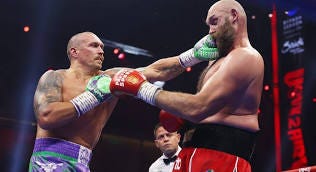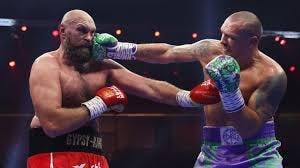“I thought I won by at least three rounds,” Tyson Fury
Everybody saw it. On Saturday afternoon, an overflow Saudi Arabian crowd got to witness every single punch and miss and clinch, the two of them awkwardly wrestling each other throughout a dozen rounds. Both men were tired and sweaty and on their feet at the finish, the crowd hollering and hooting. They wandered to their corners. The fight was over. And they looked into their handlers’ eyes, expectantly.
Inside the arena, around the ring, there were three men who held a secret. One they would not speak about, only turn in a small card. That card would suggest who each one thought won.


It didn’t matter a hoot and a holler what the fans thought, what each fighter thought, what their trainers thought, what the promoters thought. It was up to these three men, two judges and a referee. When the final bell rang, nobody knew what they were thinking. They’d turn their cards in to the referee and then their decision would be revealed to the crowd.
In these days of media overexposure, it seems as if we know everything about everybody. Attractive young women are walking up to coaches IN THE MIDDLE OF THE GAME to ask him how’s it going? (Aren’t you watching?) Players are miked-up IN THE GAME. There are statistics about everything now, how many punches a man throws in a round, how many are power punches, how many breaths they take, how many profanities their trainer uses between rounds… We know it all, it seems, except this. Who won? If both fighters are on their feet at the finish, we won’t know until they tell us.
Judging a fight is not easy. So many things happen in one three-minute round, throw a dozen of those rounds in rapid succession and you can see how confusing it can get. One fighter gets in a stunning right hand in the first minute of the round, the other fighter lands a great left hook at the end of the round. Who won the round?
Perhaps the greatest example of that final-minute rally was the Marvin Hagler vs. Sugar Ray Leonard fight where Leonard farted around, just tried to stay out of the way for the first two minutes of each round, then would flurry, generally a bunch of showy but not particularly effective punches in the final minute and he’d win the round. He took a split-decision win over Hagler doing that.
Since Fury is so big (6-9) and awkward and Usyk is a southpaw, leading with his right, instead of his left hand, which seems to tangle everything up, Saturday’s rematch between Oleksandr Usyk and Tyson Fury was not an easy fight to score. Usyk’s slippery, shifting style made him a difficult target for Fury, who is generally not a precise puncher anyway. The hulking Fury would extend his left hand, often colliding with Usyk’s right hand, his jab, then Usyk would move in and try to punch to that white 281-pound expanse of flesh and flab, then they’d clinch and start again.
Usyk had 335 amateur fights where you win bouts by landing more punches, even if they aren’t particularly hard or knockout-worthy. He’s only had 24 professional fights but at 38, he knows all the tricks, is shifty and clever.
Fury, who weighed some 50 pounds more then Usyk and had talked about destroying his opponent before the bout. But it looked as if he’d been hitting the buffet more than the heavy bag and carrying that much freight around, his trunks almost up to his nipples, he tired, understandably, as the fight wore on.
Halfway through, after six rounds, it seemed Fury had landed enough punches to have a slight advantage. But the thunderous punching power Fury had shown in the Deontay Wilder trilogy seemed to have disappeared. It seemed that, because of the configuration between the two styles, Fury’s best and most powerful punch would be the short straight right to the face as Usyk came in and indeed, he did land it several times. But either Usyk takes a heck of a lot better punch than Wilder or Fury’s power has vanished, which sometimes happens with older fighters. Because Usyk never went down.
Usyk’s persistence and peppering punches landed a little more — not by a lot, though — as the bout continued and again, WHEN he landed seemed to have considerable impact on the scoring. If you could break down the rounds into 1-minute segments, it seems Usyk always won that final minute and, evidently with it, the round.
What was interesting was at the finish was all three judges had the same score, 116-112, a four-round edge for Usyk, a more decisive win than you would have thought. Usyk did enough to win, agreed, landing more punches in the final three rounds. But a four-round edge seemed a lot to me.
Four prominent boxing promoters, Bob Arum, Oscar De La Hoya, Eddie Hearn and Frank Warren all had Fury winning by the same 116-112 score. Interesting.
Fury, of course, felt he won and his handlers did nothing in-between rounds that I could hear to tell him he was trailing. They might have thought he was winning, too.
The only time I remember when boxing officials showed HOW they were scoring a fight was when Muhammad Ali defended his title against Earnie “The Acorn” Shavers in 1977 and NBC coerced the officials to share their scorecards AS THE FIGHT WAS GOING ON. Ali’s trainer, Angelo Dundee, had someone posted in the dressing room, watching the fight, so he knew how his man was doing according to the officials and directed him strategically to a hard-fought 15-round win.
Would Fury have fought differently in those last few rounds if he knew the judges had him trailing? We’ll never know.
One thing we do know is once again, an ex-boxing champion trying to regain the heavyweight championship has failed. Floyd Patterson did it, Ali did it twice, the first time only because boxing officials had taken his title from him when he refused induction, the second time against Leon Spinks, which almost doesn’t count, and George Foreman, who regained his title twenty years after Ali had beaten him, flattening Michael Moorer.
The idea for Fury, of course, as I wrote about earlier, was to tell history to go to hell. Usyk was tough but sometimes, it’s hard to beat history.
\

